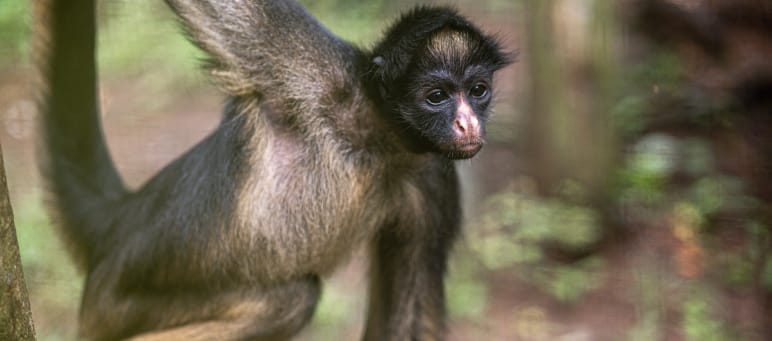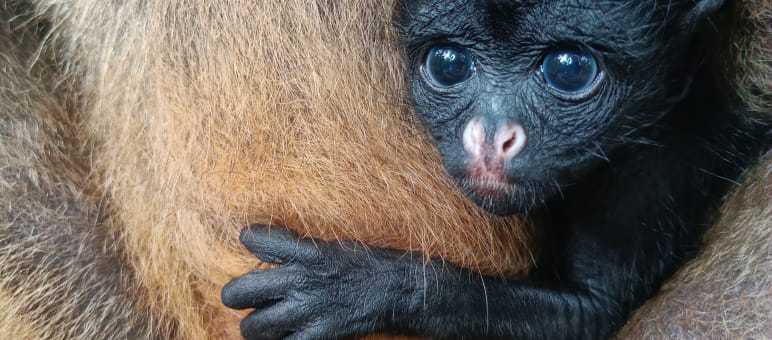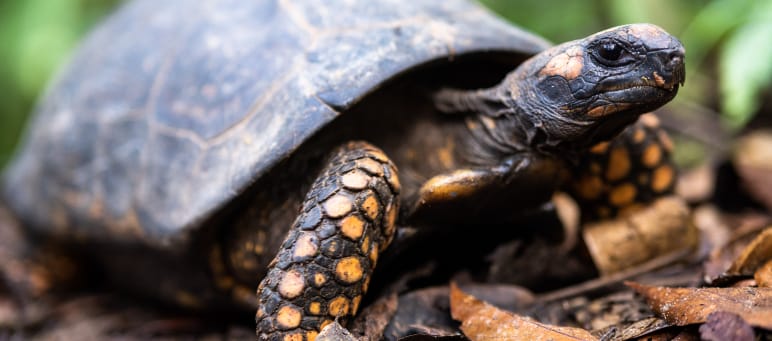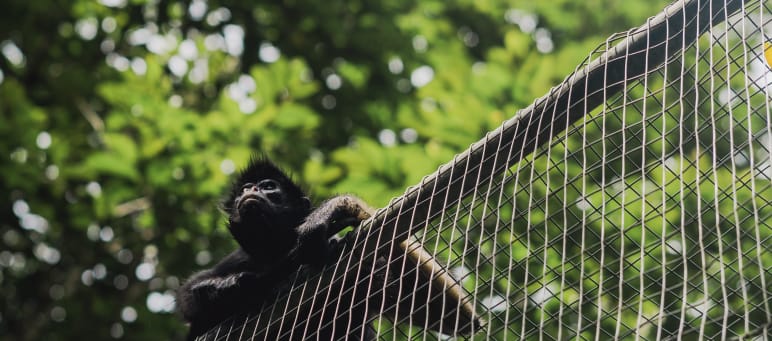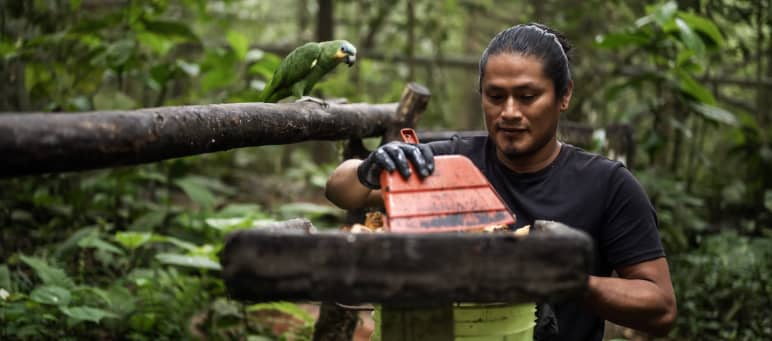Freedom for captive wildlife: the amaZOOnico wildlife conservation center
The amaZOOnico wildlife sanctuary in the Ecuadorian rainforest cares for wild animals confiscated by the authorities and prepares them for release into the wild. We support the release of white-bellied spider monkeys and Brazilian giant tortoises and enrichment of the 1,750-hectare Selva Viva protected forest with fruit trees.
Project Overview
Project FocusWildlife
Project Objective protecting the Amazon rainforest and its endangered spider monkeys and giant tortoises
Activities release of white-bellied spider monkeys and Brazilian giant tortoises, enrichment with fruit trees
Wildlife trafficking is a multi-billion dollar global business fueled by demand from unscrupulous people. In Ecuador, it is illegal to buy, sell, or keep wild animals as pets. Time and again, authorities confiscate animals from traffickers or being kept illegally by private individuals. Like animals born in captivity, they usually cannot be released into the wild without careful preparation.
What can be done with these animals?
The amaZOOnico wildlife sanctuary, located in the rainforest of Ecuador's Napo province, has been caring for such animals for 30 years. The sanctuary is located about 30 kilometers southeast of the city of Tena on the Napo River, a tributary of the Amazon. It was founded in 1993 by Angelika Raimann and Remigio Canelos, a Swiss-Ecuadorian couple.
amaZOOnico’s mission
Many of the animals arrive at the center in poor health because they have not been properly housed and fed. Sometimes sick animals or those injured by motor vehicles are brought to the sanctuary. They are examined, fed, cared for and – whenever possible – released back into the wild by amaZOOnico.
Since we opened, 3,500 wild animals have been brought to us and 1,500 have been released back into the wild.”
Accommodating the animals requires enclosures, food, medication and care by nurses and vets. amaZOOnico currently provides lifelong care for more than 200 animals that cannot be released back into the wild.
The neighboring Indigenous Kichwa communities are closely involved in the work of amaZOOnico. The founder, Remigio Canelos, is a Kichwa himself, and many of the amaZOOnico staff come from the surrounding villages. The center buys fruit to feed the animals in the villages and supports the local communities by selling handicrafts.
In addition, amaZOOnico provides environmental education and activities in schools and communities to raise awareness of nature. The wildlife center can be visited daily in the morning and offers research and volunteer opportunities for those interested.
Remigio brings a unique and vital perspective to the project: He has extensive knowledge of the behavior, handling and care of various species of mammals, birds and reptiles.”
amaZOOnico activities supported by Rainforest Rescue
1. Release of white-bellied spider monkeys into the wild
White-bellied spider monkeys (Ateles belzebuth) live in groups of 20 to 40 individuals in the northwestern Amazon. These diurnal primates are adapted to life in the treetops. Spider monkeys are vital for the conservation of forests and biodiversity. The animals are the most important seed dispersers for many tree species in the northwestern Amazon rainforest. The primates consume over 100 different types of fruit, swallowing the seeds they contain and then dispersing them intact with their excrement throughout the rainforest. The trees then germinate particularly well and can take root in new locations far away from the mother tree.
In an enclosed five-hectare area, the spider monkeys are prepared for release in a three-phase process:
First, the monkeys are trained to avoid behaviors such as staying on the ground or approaching humans. Their behavior is monitored using standardized ethograms to assess “positive” or “negative” changes. The monkeys are then released from their enclosures and continue to be fed once a day. The final step is their release into the wild, where they live without further human assistance. During the last two phases, the animals wear GPS collars and are monitored by teams of biologists.
2. Research on the release behavior of Brazilian giant tortoises
Brazilian giant tortoises (Chelonoidis denticulatus) are solitary terrestrial animals found in tropical areas of South America. Recent research suggests that the tortoises have highly individual personalities and associated behavioral patterns that can predict the success or failure of reintroduction efforts. In addition to reintroduction, the goal of this project is to establish a standard protocol for assessing the viability of Brazilian giant tortoises in the wild based on behavioral data.
Our work is helping to improve the success of reintroductions of endangered Brazilian giant tortoises not only at amaZOOnico, but throughout their range.”
–Dr. Scott Alan Ford, Director of Research and Conservation
Both white-bellied spider monkeys and Brazilian giant tortoises are fruit-eaters and are listed as vulnerable or endangered by the IUCN. They are important seed dispersers and therefore crucial to the regeneration of tropical rainforests. Trade in these animals is prohibited under the Convention on International Trade in Endangered Species of Wild Fauna and Flora (CITES).
3. Enrichment of fruit trees in the Selva Viva rainforest
The animals are usually released into the surrounding 1,750-hectare private protected forest area (Bosque Protector) of Selva Viva, which is managed by the FCP Selva Viva Foundation and financed by the Swiss Rainforest Protection Cooperative (GSR). Six spider monkeys and five lowland tapirs (Tapirus terrestris) are already living there – in addition to an enormous variety of other species.
To improve the nutrition of the animals, key fruit tree species are being enriched on two hectares of forest. For this purpose, a tree nursery is being established, where wild seeds collected in the forest will be sown and the seedlings will be raised before being planted in the forest. This will also enrich the genetic diversity of the fruit trees.
Videos (in German):
Releasing spider monkeys into the rainforest
Planting fruit trees for endangered wildlife
see https://www.amazoonicorescue.org/volunteer/volunteer-at-amazoonico
Inaturalist 2023. Observaciones de amazoonico: https://www.inaturalist.org/observations/amazoonico
